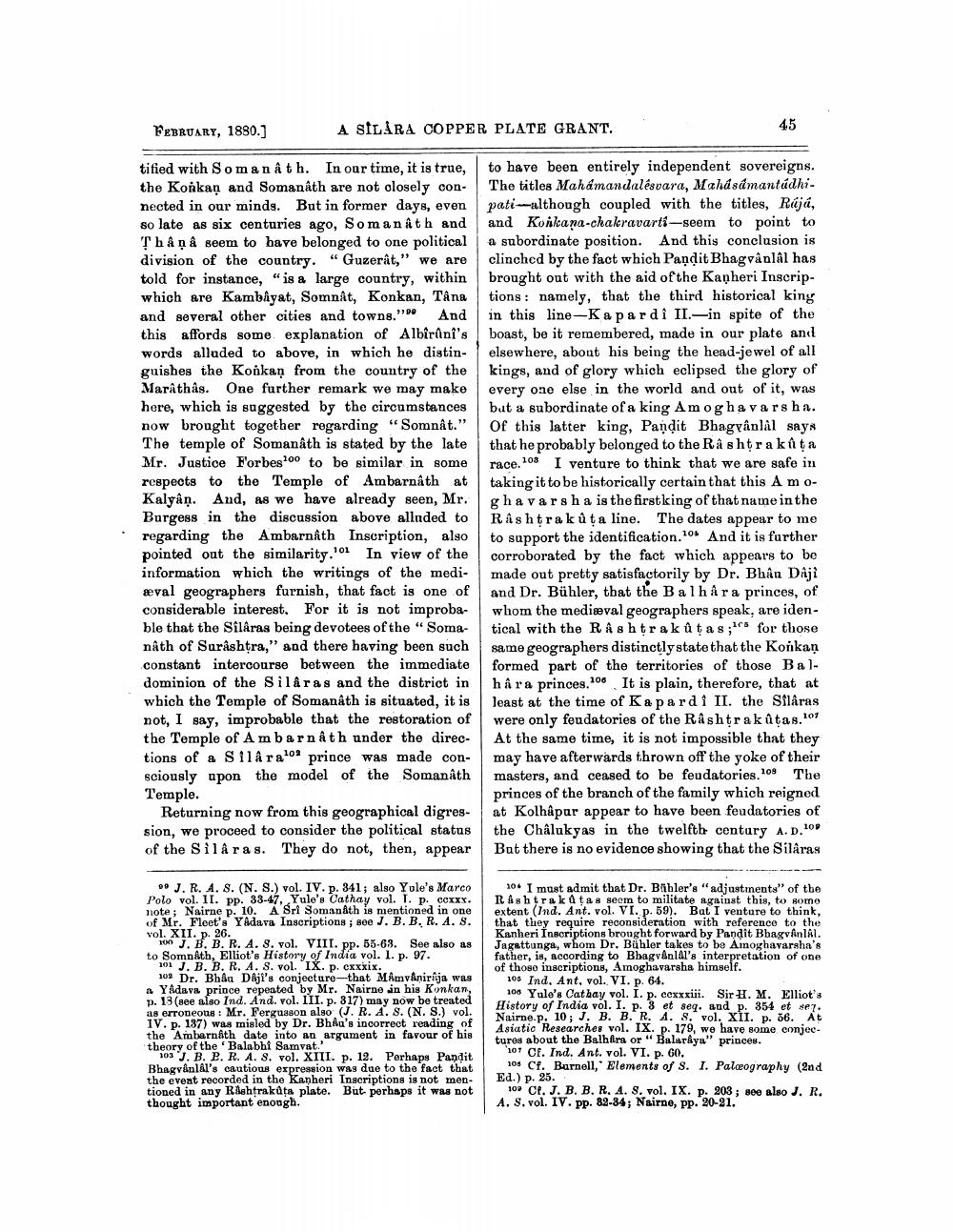________________
A SILARA COPPER PLATE GRANT.
FEBRUARY, 1880.]
tified with So manâth. In our time, it is true, the Konkan and Somanâth are not closely connected in our minds. But in former days, even so late as six centuries ago, Somanâth and Thânâ seem to have belonged to one political division of the country. "Guzerât," we are told for instance, "is a large country, within which are Kambâyat, Somnât, Konkan, Tâna and several other cities and towns." And this affords some explanation of Albirûnî's words alluded to above, in which he distinguishes the Konkan from the country of the Marâthâs. One further remark we may make here, which is suggested by the circumstances now brought together regarding "Somnât." The temple of Somanâth is stated by the late Mr. Justice Forbes 100 to be similar in some respects to the Temple of Ambarnath at Kalyan. And, as we have already seen, Mr. Burgess in the discussion above alluded to regarding the Ambarnath Inscription, also pointed out the similarity.10 In view of the information which the writings of the mediæval geographers furnish, that fact is one of considerable interest. For it is not improbable that the Sîlâras being devotees of the "Somanâth of Surâshtra," and there having been such constant intercourse between the immediate dominion of the Silâras and the district in which the Temple of Somanâth is situated, it is not, I say, improbable that the restoration of the Temple of Ambarnath under the directions of a Silâ ra102 prince was made consciously upon the model of the Somanâth Temple.
Returning now from this geographical digression, we proceed to consider the political status of the Sila ras. They do not, then, appear
99 J. R. A. S. (N. S.) vol. IV. p. 341; also Yule's Marco Polo vol. II. pp. 33-47, Yule's Cathay vol. I. p. ccxxx. note; Nairne p. 10. A Sri Somanâth is mentioned in one of Mr. Fleet's Yadava Inscriptions; see J. B. B. R. A. S. vol. XII. p. 26.
100 J. B. B. R. A. S. vol. VIII. pp. 55-63. See also as to Somnath, Elliot's History of India vol. 1. p. 97. 101 J. B. B. R. A. S. vol. IX. p. cxxxix.
102 Dr. Bhâu Diji's conjecture-that Mâmvânirija was a Yadava prince repented by Mr. Nairne in his Konkan, p. 13 (see also Ind. And. vol. III. p. 317) may now be treated as erroneous: Mr. Fergusson also (J. R. A. S. (N. S.) vol. IV. p. 137) was misled by Dr. Bhau's incorrect reading of the Ambarnath date into an argument in favour of his theory of the 'Balabhi Samvat.'
103 J. B. P. R. A. S. vol. XIII. p. 12. Perhaps Pandit Bhagvanlal's cautions expression was due to the fact that the event recorded in the Kanheri Inscriptions is not mentioned in any Rashtrakuta plate. But perhaps it was not thought important enough.
45
to have been entirely independent sovereigns. The titles Mahámandalêsvara, Mahásámantúdhipati-although coupled with the titles, Raja, and Konkana-chakravarti-seem to point to a subordinate position. And this conclusion is clinched by the fact which Pandit Bhagvanlâl has brought out with the aid of the Kanheri Inscriptions: namely, that the third historical king in this line-Kapardi II.-in spite of the boast, be it remembered, made in our plate and elsewhere, about his being the head-jewel of all kings, and of glory which eclipsed the glory of every one else in the world and out of it, was but a subordinate of a king Amoghavarsha. Of this latter king, Pandit Bhagvânlal says that he probably belonged to the Rashtrakuta race. 108 I venture to think that we are safe in taking it to be historically certain that this A moghavarsha is the firstking of that name in the Rashtrakuta line. The dates appear to me to support the identification.10 And it is further corroborated by the fact which appears to be made out pretty satisfactorily by Dr. Bhân Dâji and Dr. Bühler, that the Balhar a princes, of whom the medieval geographers speak, are identical with the Rashtrakutas; for those same geographers distinctly state that the Konkan formed part of the territories of those Balhâra princes. 106 It is plain, therefore, that at least at the time of Kapardi II. the Silâras were only feudatories of the Rashtrakutas.107 At the same time, it is not impossible that they may have afterwards thrown off the yoke of their masters, and ceased to be feudatories.10s The princes of the branch of the family which reigned at Kolhâpur appear to have been feudatories of the Châlukyas in the twelfth century A. D.10 But there is no evidence showing that the Silâras
10 I must admit that Dr. Bibler's "adjustments" of the Rashtrakutas seem to militate against this, to some extent (Ind. Ant. vol. VI. p. 59). But I venture to think, that they require reconsideration with reference to the Kanheri Inscriptions brought forward by Pandit Bhagvanlal. Jagattunga, whom Dr. Bühler takes to be Amoghavarsha's father, is, according to Bhagvanlal's interpretation of one of those inscriptions, Amoghavarsha himself.
105 Ind. Ant, vol. VI. p. 64.
108 Yule's Cathay vol. I. p. ccxxxiii. Sir H. M. Elliot's History of India vol. I. p. 3 et seq. and p. 354 et seq. Nairne.p. 10; J. B. B. R. A. S. vol. XII. p. 56. At Asiatic Researches vol. IX. p. 179, we have some conjectures about the Balhara or "Balaraya" princes.
107 Cf. Ind. Ant. vol. VI. p. 60.
10 Cf. Barnell, Elements of S. I. Palæography (2nd Ed.) p. 25.
102 Cf. J. B. B. R. A. S. vol. IX. p. 203; see also J. R. A. S. vol. IV. pp. 82-34; Nairne, pp. 20-21.




